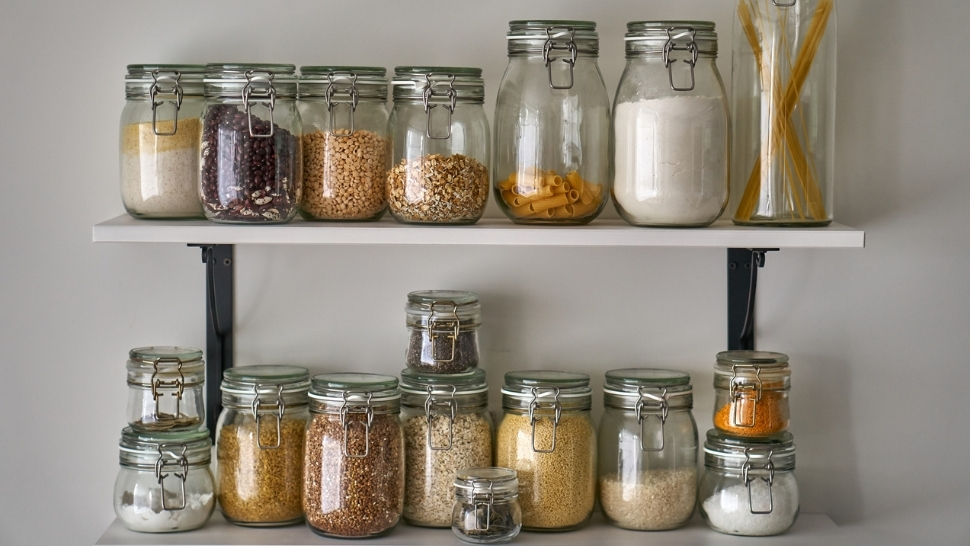
As millions of Americans continue to make more meals at home, many people have food safety questions. How long can foods be safely stored? What’s the best way to reheat leftovers? How long do pantry staples last? As boring as it might seem, understanding safe food handling basics can be the difference between having healthy, time-saving leftovers and a case of…well, the unmentionable (and uncomfortable) “stomach flu” no one wants!
First things first — the golden rule of food safety is keep hot foods hot, and cold foods cold. This means foods must not hang out in the food safety danger zone (between 40° – 140°F) for longer than two hours — this is where dangerous bacteria grows best. Beyond knowing safe temperatures, here are other considerations when storing food.
Refrigerator
Refrigerate perishable food within two hours (make it one hour if outside temperatures are over 90°F). Hot foods must cool to less than 40°F during this window of time, so separate large batches of food into smaller portions to allow them to cool more quickly (and keep lids off or loose so heat can escape). Length of storage is also critical. Here are some guidelines on how long common prepared foods can be safely refrigerated:
- Cooked leftovers: 3-4 days
- Deli salads: 3-5 days
- Deli meats: 3-5 days, when sliced fresh
Freezer
Freezing can be a great way to make perishable items last longer, as it prevents the growth of bacteria, mold, and yeast that causes food spoilage or food poisoning. Most foods can be frozen with the exception of some premade foods, unopened canned goods, or eggs in shell. Here are few tips for (freezer) success:
- Store prepared foods in small batches. Freezing foods in small portions allows you to easily reheat as-needed. You can even try freezing foods individually and then combining in a larger storage container once frozen allowing you to take what you need, when you need it. Use this freezing method for foods such as cookie dough, burger or vegetable patties, and seasonal berries.
- Label and date all foods. Help your future self know exactly what you have and how long it’s been frozen. Pro tip: Keep a list of main items you’ve frozen pinned to your refrigerator with a use by date for future reference (who hasn’t forgotten that delicious dish in the back of the freezer?).
- Thaw safely. The safest way to thaw frozen food is slowly in the refrigerator to ensure a safe temperature throughout the process. Check out this guide to other safe thawing methods.
- Once defrosted, use fruits and vegetables strategically. Water expands and crystalizes during the freezing process. While the taste and nutrient content of these foods is often the same, the texture will differ. Previously frozen produce is better used soups, smoothies, or sauces where softer textures are acceptable.
The Pantry
Here are some best practices that will extend the shelf-life of foods in your pantry and increase your food safety factor:
- Keep it cool. The ideal environment for a pantry is cool, dark, dry, and clean. A temperature range between 50° – 70°F is best.
- First in, first out. Place older containers in front to use first.
- Store dry foods in airtight containers. After opening dry foods such as rice, pasta, or flour, store them in an airtight container. This will keep insects and other pests out and prevent food from absorbing moisture and odors.
- Dates matter on dried foods. After opening, use dried fruits, nuts, and seeds within 1-3 months or transfer to the refrigerator for longer shelf life.
Reheating Leftovers
Leftovers seem to be polarizing — you either love them or hate them. While the microwave has its place, there are a few other tricks to make leftovers taste just as good as they day they were served. Whenever possible, reheat food using the same equipment the food was originally prepared in for best taste and texture. Here are a few tips for (reheating) success:
- Break out the pots and pans. Reheat sautés and stir-fries over low heat, add a splash of water or stock to bring rice and noodle dishes back to life, or slice proteins thinly and sear in a hot skillet to heat but not overcook.
- Heat up your oven or toaster oven. Put fried or breaded foods back in dry heat to revive their crispy exterior, toss your pizza or grilled sandwiches in the oven to re-crisp, and cover and reheat seafood and meats in the oven to prevent them from drying out.
- Save the microwave for foods with high moisture. Soups, stews, and casseroles tend to maintain their original texture and moisture level in the microwave. Cover with a damp paper towel, adjust your power level to seventy – eighty percent, and cook a bit longer for best results.
- Heat it well. Reheat foods to at least 165°F to prevent foodborne illness. And remember, if it smells funky, looks slimy, or has mold, err on the side of caution and compost or throw it out.
Whether you’re eating out or cooking at home, storing leftovers or planning ahead, knowing how to keep food safe during storage is critical to staying well. Refrigerator and freezer storage recommendations vary and can be tricky so keep this guide close by for reference.